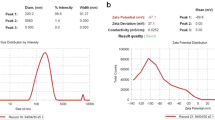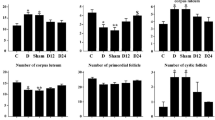Abstract
Background
17β-estradiol (E2) has well-established cardioprotective, antioxidant and neuroprotective role, and exerts a vast range of biological effects in both sexes. Dipeptidyl peptidase III (DPP III) is protease involved as activator in Keap1–Nrf2 signalling pathway, which is important in cellular defense to oxidative and electrophilic stress. It is generally accepted that oxidative stress is crucial in promoting liver diseases.
Objective
To examine the effect of E2 on the expression of DPP III and haeme oxygenase 1 (HO-1) in liver of adult CBA/H mice of both sexes.
Methods
Gene and protein expressions of studied enzymes were determined by quantitative real-time PCR and Western blot analysis. Immunohistochemistry was performed to analyse the localization of both proteins in different liver cell types.
Results
Ovariectomy diminished expression of DPP III and HO-1 proteins. E2 administration abolished this effect, and even increased these proteins above the control. A significant enhancement in DPP III protein was found in E2-treated males, as well. A decrease in the expression of HO-1, but not of the DPP III gene, was detected in the liver of ovariectomized females. HO-1 protein was found localized in the pericentral areas of hepatic lobules (Kupffer cells and hepatocytes), whilst DPP III showed a uniform distribution within hepatic tissue.
Conclusions
We demonstrate for the first time that E2 influences the protein level of DPP III in vivo, and confirm earlier finding on HO-1 gene upregulation by 17β-estradiol. These results additionally confer new insights into complexity of protective action of E2.





Similar content being viewed by others
References
Wright AF, Jacobson SG, Cideciyan AV, Roman AJ, Shu X, Vlachantoni D, McInnes RR, Riemersma RA (2004) Lifespan and mitochondrial control of neurodegeneration. Nat Genet 36:1153–1158. doi:10.1038/ng1448
Stirone C, Duckles SP, Krause DN, Procaccio V (2005) Estrogen increases mitochondrial efficiency and reduces oxidative stress in cerebral blood vessels. Mol Pharmacol 68:959–965. doi:10.1124/mol.105.014662
Vina J, Borras C, Gambini J, Sastre J, Pallardo FV (2005) Why females live longer than males? Importance of the upregulation of longevity-associated genes by oestrogenic compounds. FEBS Lett 579:2541–2545. doi:10.1016/j.febslet.2005.03.090
Shimizu I (2003) Impact of oestrogens on the progression of liver disease. Liver Int 23:63–69. doi:10.1034/j.1600-0676.2003.00811.x
Wassmann S, Baumer AT, Strehlow K, van Eickels M, Grohe C, Ahlbory K, Rosen R, Bohm M, Nickenig G (2001) Endothelial dysfunction and oxidative stress during estrogen deficiency in spontaneously hypertensive rats. Circulation 103:435–441. doi:10.1161/01.CIR.103.3.435
Borras C, Gambini J, Gomez-Cabrera MC, Sastre J, Pallardo FV, Mann GE, Vina J (2005) 17beta-oestradiol up-regulates longevity-related, antioxidant enzyme expression via the ERK1 and ERK2[MAPK]/NFkappaB cascade. Aging Cell 4:113–118. doi:10.1111/j.1474-9726.2005.00151.x
Yu J, Zhao Y, Li B, Sun L, Huo H (2012) 17beta-estradiol regulates the expression of antioxidant enzymes in myocardial cells by increasing Nrf2 translocation. J Biochem Mol Toxicol 26:264–269. doi:10.1002/jbt.21417
Ferrandiz ML, Devesa I (2008) Inducers of heme oxygenase-1. Curr Pharm Des 14:473–486. doi:10.2174/138161208783597399
Dore S, Takahashi M, Ferris CD, Zakhary R, Hester LD, Guastella D, Snyder SH (1999) Bilirubin, formed by activation of heme oxygenase-2, protects neurons against oxidative stress injury. Proc Natl Acad Sci USA 96:2445–2450. doi:10.1073/pnas.96.5.2445
Li N, Venkatesan MI, Miguel A, Kaplan R, Gujuluva C, Alam J, Nel A (2000) Induction of heme oxygenase-1 expression in macrophages by diesel exhaust particle chemicals and quinones via the antioxidant-responsive element. J Immunol 165:3393–3401. doi:10.4049/jimmunol.165.6.3393
Hancock R, Bertrand HC, Tsujita T, Naz S, El-Bakry A, Laoruchupong J, Hayes JD, Wells G (2012) Peptide inhibitors of the Keap1–Nrf2 protein–protein interaction. Free Radic Biol Med 52:444–451. doi:10.1016/j.freeradbiomed.2011.10.486
Hast BE, Goldfarb D, Mulvaney KM, Hast MA, Siesser PF, Yan F, Hayes DN, Major MB (2013) Proteomic analysis of ubiquitin ligase KEAP1 reveals associated proteins that inhibit NRF2 ubiquitination. Cancer Res 73:2199–2210. doi:10.1158/0008-5472.CAN-12-4400
Abramić M, Zubanović M, Vitale L (1988) Dipeptidyl peptidase III from human erythrocytes. Biol Chem Hoppe Seyler 369:29–38
Abramić M, Šimaga S, Osmak M, Čičin-Šain L, Vukelić B, Vlahoviček K, Dolovčak L (2004) Highly reactive cysteine residues are part of the substrate binding site of mammalian dipeptidyl peptidases III. Int J Biochem Cell Biol 36:434–446
Baršun M, Jajčanin N, Vukelić B, Špoljarić J, Abramić M (2007) Human dipeptidyl peptidase III acts as a post-proline-cleaving enzyme on endomorphins. Biol Chem 388:343–348. doi:10.1515/BC.2007.039
Liu Y, Kern JT, Walker JR, Johnson JA, Schultz PG, Luesch H (2007) A genomic screen for activators of the antioxidant response element. Proc Natl Acad Sci USA 104:5205–5210. doi:10.1073/pnas.0700898104
Zhan H, Yamamoto Y, Shumiya S, Kunimatsu M, Nishi K, Ohkubo I, Kani K (2001) Peptidases play an important role in cataractogenesis: an immunohistochemical study on lenses derived from Shumiya cataract rats. Histochem J 33:511–521. doi:10.1023/A:1014943522613
Šimaga S, Babić D, Osmak M, Šprem M, Abramić M (2003) Tumor cytosol dipeptidyl peptidase III activity is increased with histological aggressiveness of ovarian primary carcinomas. Gynecol Oncol 91:194–200. doi:10.1016/S0090-8258(03)00462-1
He M, Mangiameli DP, Kachala S, Hunter K, Gillespie J, Bian X, Shen HC, Libutti SK (2010) Expression signature developed from a complex series of mouse models accurately predicts human breast cancer survival. Clin Cancer Res 16:249–259. doi:10.1158/1078-0432.CCR-09-1602
Persky AM, Green PS, Stubley L, Howell CO, Zaulyanov L, Brazeau GA, Simpkins JW (2000) Protective effect of estrogens against oxidative damage to heart and skeletal muscle in vivo and in vitro. Proc Soc Exp Biol Med 223:59–66. doi:10.1046/j.1525-1373.2000.22308.x
Einecke G, Fairhead T, Hidalgo LG, Sis B, Turner P, Zhu LF, Bleackley RC, Hadley GA, Famulski KS, Halloran PF (2006) Tubulitis and epithelial cell alterations in mouse kidney transplant rejection are independent of CD103, perforin or granzymes A/B. Am J Transplant 6:2109–2120. doi:10.1111/j.1600-6143.2006.01483.x
Špoljarić J, Tomić A, Vukelić B, Salopek Sondi B, Agić D, Tomić S, Abramić M (2011) Human dipeptidyl peptidase III: the role of Asn406 in ligand binding and hydrolysis. Croat Chem Acta 84:259–268. doi:10.5562/cca1808
Haas CA, Deller T, Krsnik Z, Tielsch A, Woods A, Frotscher M (2000) Entorhinal cortex lesion does not alter reelin mRNA expression in the dentate gyrus of young and adult rats. Neuroscience 97:25–31
Shin SM, Yang JH, Ki SH (2013) Role of the Nrf2-ARE pathway in liver diseases. Oxid Med Cell Longev 2013:1–9
Cichoż-Lach H, Michalak A (2014) Oxidative stress as a crucial factor in liver diseases. World J Gastroenterol 20:8082–8091
Su H, van Dam GM, Buis CI, Visser DS, Hesselink JW, Schuurs TA, Leuvenink HGD, Contag CH, Porte RJ (2006) Spatiotemporal expression of Heme Oxygenase 1 detected by in vivo bioluminiscence after hepatic ischemia in HO-1/Luc mice. Liver Transplanation 12:1634–1639
Levonen AL, Hill BG, Kansanen E, Zhang J, Darley-Usmar VM (2014) Redox regulation of antioxidants, autophagy, and the response to stress: implications for electrophile therapeutics. Free Rad Biol Med (in press)
Shukla AA, Jain M, Chauhan SS (2010) Ets-1/Elk-1 is a critical mediator of dipeptidyl-peptidase III transcription in human glioblastoma cells. FEBS J 277:1861–1875. doi:10.1111/j.1742-4658.2010.07603.x
Singh R, Sharma MC, Sarkar C, Singh M, Chauhan SS (2014) Transcription factor C/EBP-beta mediates downregulation of dipeptidyl-peptidase III expression by interleukin-6 in human glioblastoma cells. FEBS J 281:1629–1641. doi:10.1111/febs.12728
Fukasawa K, Fukasawa KM, Kanai M, Fujii S, Hirose J, Harada M (1998) Dipeptidyl peptidase III is a zinc metallo-exopeptidase. Molecular cloning and expression. Biochem J 329(Pt 2):275–282
Abramić M, Schleuder D, Dolovčak L, Schroder W, Strupat K, Sagi D, Peter-Katalini J, Vitale L (2000) Human and rat dipeptidyl peptidase III: biochemical and mass spectrometric arguments for similarities and differences. Biol Chem 381:1233–1243. doi:10.1515/BC.2000.151
Bezerra GA, Dobrovetsky E, Viertlmayr R, Dong A, Binter A, Abramic M, Macheroux P, Dhe-Paganon S, Gruber K (2012) Entropy-driven binding of opioid peptides induces a large domain motion in human dipeptidyl peptidase III. Proc Natl Acad Sci USA 109:6525–6530. doi:10.1073/pnas.1118005109
Liang K, Yang L, Yin C, Xiao Z, Zhang J, Liu Y, Huang J (2010) Estrogen stimulates degradation of beta-amyloid peptide by up-regulating neprilysin. J Biol Chem 285:935–942. doi:10.1074/jbc.M109.051664
Ogawa M, Yamaji R, Higashimura Y, Harada N, Ashida H, Nakano Y, Inui H (2011) 17beta-estradiol represses myogenic differentiation by increasing ubiquitin-specific peptidase 19 through estrogen receptor alpha. J Biol Chem 286:41455–41465. doi:10.1074/jbc.M111.276824
Danielsen JM, Sylvestersen KB, Bekker-Jensen S, Szklarczyk D, Poulsen JW, Horn H, Jensen LJ, Mailand N, Nielsen ML (2011) Mass spectrometric analysis of lysine ubiquitylation reveals promiscuity at site level. Mol Cell Proteomics 10(M110):003590. doi:10.1074/mcp.M110.003590
Manolagas SC (2010) From estrogen-centric to aging and oxidative stress: a revised perspective of the pathogenesis of osteoporosis. Endocr Rev 31:266–300. doi:10.1210/er.2009-0024
Sobočanec S, Balog T, Šarić A, Šverko V, Žarković N, Čipak Gašparović A, Žarković K, Waeg G, Mačak Šafranko Ž, Kušić B, Marotti T (2010) Cyp4a14 overexpression induced by hyperoxia in female CBA mice as a possible contributor of increased resistance to oxidative stress. Free Radic Res 44:181–190. doi:10.3109/10715760903390820
Šarić A, Sobočanec S, Mačak Šafranko Ž, Popović-Hadžija M, Aralica G, Korolija M, Kušić B, Balog T (2014) Female headstart in resistance to hyperoxia-induced oxidative stress in mice. Acta Biochim Pol (in press)
Šarić A, Sobočanec S, Balog T, Popović Hadžija M, Kušić B, Marotti T (2012) Female headstart in key factors responsible for mitochondrial functioning as a protective mechanism towards hyperoxia oxidative injury. Free Radic Biol Med 53(Supplement 1):S223
Toth B, Yokoyama Y, Kuebler JF, Schwacha MG, Rue LW 3rd, Bland KI, Chaudry IH (2003) Sex differences in hepatic heme oxygenase expression and activity following trauma and hemorrhagic shock. Arch Surg 138(12):1375–1382
Acknowledgments
The authors would like to thank Iva Pešun Međimorec for her excellent technical contribution in performing surgical procedures of ovariectomy and Ana Jagust for her excellent technical assistance in performing immunohistochemical analyses. This research is funded by Croatian Ministry of Science, Education and Sports, Grant No. 098-0982464-1647, Grant No. 098-1191344-2938 and IBRO 2013 RHP.
Conflict of interest
The authors declare no conflict of interest or any financial interest.
Author information
Authors and Affiliations
Corresponding author
Rights and permissions
About this article
Cite this article
Mačak Šafranko, Ž., Sobočanec, S., Šarić, A. et al. The effect of 17β-estradiol on the expression of dipeptidyl peptidase III and heme oxygenase 1 in liver of CBA/H mice. J Endocrinol Invest 38, 471–479 (2015). https://doi.org/10.1007/s40618-014-0217-z
Received:
Accepted:
Published:
Issue Date:
DOI: https://doi.org/10.1007/s40618-014-0217-z




